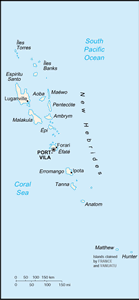The Geography of Vanuatu
The Geography of Vanuatu
Ni-Vanuatu Geography
Location: Oceania, group of islands in the South Pacific Ocean, about three-quarters of the way from Hawaii to Australia
Geographic coordinates: 16 00 S, 167 00 E
Map references: Oceania
Area: total: 12,200 sq km land: 12,200 sq km water: 0 sq km note: includes more than 80 islands, about 65 of which are inhabited
Area - comparative: slightly larger than Connecticut
Land boundaries: 0 km
Coastline: 2,528 km
Maritime claims: measured from claimed archipelagic baselines territorial sea: 12 nm contiguous zone: 24 nm exclusive economic zone: 200 nm continental shelf: 200 nm or to the edge of the continental margin
Climate: tropical; moderated by southeast trade winds from May to October; moderate rainfall from November to April; may be affected by cyclones from December to April
Terrain: mostly mountainous islands of volcanic origin; narrow coastal plains
Elevation extremes: lowest point: Pacific Ocean 0 m highest point: Tabwemasana 1,877 m
Natural resources: manganese, hardwood forests, fish
Land use: arable land: 1.64% permanent crops: 6.97% other: 91.39% (2005)
Irrigated land: NA
Natural hazards: tropical cyclones or typhoons (January to April); volcanic eruption on Aoba (Ambae) island began 27 November 2005, volcanism also causes minor earthquakes; tsunamis
Environment - current issues: most of the population does not have access to a reliable supply of potable water; deforestation
Environment - international agreements: party to: Antarctic-Marine Living Resources, Biodiversity, Climate Change, Climate Change-Kyoto Protocol, Desertification, Endangered Species, Law of the Sea, Marine Dumping, Ozone Layer Protection, Ship Pollution, Tropical Timber 94 signed, but not ratified: none of the selected agreements
Geography - note: a Y-shaped chain of four main islands and 80 smaller islands; several of the islands have active volcanoes


